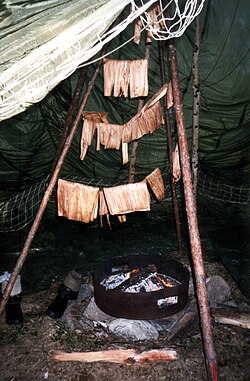Bark bread

Drying inner bark (phloem) from scots pine over open fire
|
|
| Type | Famine food, Bread |
|---|---|
| Place of origin | Scandinavia |
| Main ingredients | Flour, water, inner bark (e.g. phloem) of plants |
| |
|
Bark bread is a form of famine food made by adding ground phloem to the flour as an extender to make it last longer.
Bark bread seems to be a primarily Scandinavian tradition. Mention of it is found in medieval literature and may have an even older tradition among the Sami people.
During the 18th and early 19th century Northern Europe experienced several very bad years of crop failure, particularly during the Little Ice Age of the mid-18th century. The grain harvest was badly affected, and creative solutions to make the flour last longer were introduced. In 1742, samples of "emergency bread" were sent from Kristiansand, Norway, to the Royal Administration in Copenhagen, among them bark bread, bread made from grainless husks and bread made from burned bones. During the Napoleonic Wars, moss too was used for human consumption.
The last time bark bread was used as famine food in Norway was during the Napoleonic Wars. The introduction of the potato as a staple crop gave the farmers alternative crops when grain production failed, so that bark bread and moss cakes were no longer needed. In Northern Sweden, traces of Sami harvest of bark from Scots pine are known from the 1890s, and in Finland pettuleipä (literally "pinewood-bark bread") was produced as ersatz bread during the Finnish Civil War of 1918.
Finger sized twigs and branches were collected from deciduous trees and shrubs, and the bark split and the inner bark (the phloem and sometimes the vascular cambium) collected while still fresh. The yellow or green inner bark (depending on tree species) was dried over open fire, in an oven or dried in the sun for a few days. A mortar or mill was used to grind the bark to a fine powder to add to the flour. The dried bark pieces could also be added directly to the grain during milling. The bread was then baked the normal way adding yeast and salt.
...
Wikipedia
